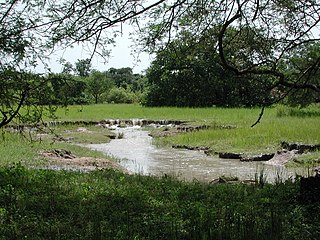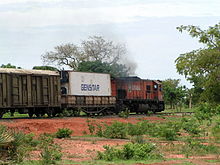
Transport in Burkina Faso consists primarily of road, air and rail transportation. The World Bank classified country's transportation as underdeveloped but noted that Burkina Faso is a natural geographic transportation hub for West Africa.

Ivory Coast invested remarkably in its transport system. Transport Infrastructures are much more developed than they are other West African countries despite a crisis that restrained their maintenance and development. Since its independence in 1960, Ivory Coast put an emphasis on increasing and modernizing the transport network for human as well as for goods. Major infrastructures of diverse nature were built including railways, roads, waterways, and airports. In spite of the crisis, neighbor countries still strongly depend on the Ivorian transport network for importing, exporting, and transiting their immigrants to Ivory Coast.

Koudougou is a city in Burkina Faso's Boulkiemdé Province. It is located 75 kilometres (47 mi) west of Ouagadougou, the capital of Burkina Faso. With a population of 160,239 (2019), it is the third most populous city in Burkina Faso after Ouagadougou and Bobo Dioulasso, and is mainly inhabited by the Gurunsi and Mossi ethnic groups. Koudougou is situated on the only railway line in Burkina Faso and has some small industries, a market, a university and provincial government offices.

Banfora is a city in southwestern Burkina Faso, with a population of 117,452 making it the sixth most populous city in Burkina Faso. It is the capital of the Comoe province. The city lies 85 kilometres (53 mi) south-west of Bobo-Dioulasso, on the Abidjan – Ouagadougou Railway. The Cascades de Karfiguéla are a series of waterfalls close to Banfora.

The Trans-Gabon Railway is the only railway in Gabon. It runs 670 km (420 mi) east from Owendo port station in Libreville to Franceville via numerous stations, the main ones being Ndjolé, Lopé, Booué, Lastoursville and Moanda.

Niangoloko is a town and seat of the Niangoloko Department in southwestern Burkina Faso. It is located near the city of Banfora and the border with Côte d'Ivoire. The town has a population of 33,292.
Rail transport in Morocco was initially developed during the protectorate. It functioned primarily as a means to mobilize colonial troops and to transport natural resources. Later, a standard-gauge network was built.

Benin has a total of 578 km (359 mi) of single track, 1,000 mm railway. Rail construction began around 1900, with regular services commencing in 1906; rail operation was taken into government control in 1930.

There are 622 kilometres of 1,000 mmmetre gauge railway in Burkina Faso, which run from Kaya to the border with Côte d'Ivoire and is part of the Abidjan-Ouagadougou railway. As of June 2024, 'Sitarail' does not operate a passenger train to Abidjan.

Ivory Coast has 660 kilometres (410 mi) of railway. The track gauge is 1,000 mm.

The Tramway d'Avranches was a 2.7 kilometres long tramway system serving the coastal town of Avranches, France.

The history of rail transport in Mauritania began in 1940, with the commencement of preparatory work for the construction of the Mauritania Railway, a single track, 704 km (437 mi) standard gauge line connecting a then proposed iron mine in Zouerate with the port of Nouadhibou, via Fderik and Choum. Construction of the line began in 1961 and was completed in 1963.

There is currently one railway in Niger, built between 2014 and 2016 between Niamey and Dosso by the French Bolloré conglomerate. The objective was to connect Niamey to the rail network in Benin and thus to the coast. But competing commercial interests by several parties resulted in endless litigation and the connection to Benin never materialized. So the 145 km Niamey-Dosso stretch now lies orphaned and unused, with the tracks ending in the middle of nowhere some 6 km south of Dosso. After several years of neglect the tracks are already damaged to such an extent in some places, that they have become unusable. At the Niamey Terminus Station, the rails are kinked to such an extent by the summer heat that the train would not be able to leave the station.

The Autonomous Port of Abidjan is a commercial port at Treichville, in southern Abidjan, Ivory Coast. It is a transshipment and intermodal facility and is managed as a public industrial and commercial establishment; the Director-General is Hien Sié.
On 21 October 2016, a Camrail inter-city passenger train travelling from Cameroon's capital, Yaoundé, to its largest city, Douala, derailed in Eséka, Centre Region. By 30 October 2016, the official number of casualties had reached 79 dead, with 550 injured. It was the deadliest rail crash on the African continent since the August 2007 Benaleka train accident.

On 6 September 2016, the railway bridge over the Nzi River collapsed, cutting the rail link between Ivory Coast and Burkina Faso. Partial services on the line resumed on 10 September, with repairs estimated to take about two weeks.
Timpoko Helène Kienon-Kabore is an archaeologist from Côte d'Ivoire, who is Professor at the Research of Human Society and Science Unit at the Université Félix Houphouët-Boigny. A specialist in historical metallurgy, she is an advisor on archaeological heritage at the Ministry of Culture and Francophonie of Côte d'Ivoire and was president of the Association of Archaeologists of West Africa from 2010-2014.
Charles François Maurice Houdaille (1858–1916) was a French army officer. An engineer by training, he was seconded to the colonies ministry and assigned to French West Africa.

The Avranches–Saint-James tramway was a 17 kilometres metre gauge railway on the English Channel in the Manche département in the Normandy region of France, which was put into service on 29 July 1901 and operated until 31 December 1933.
















